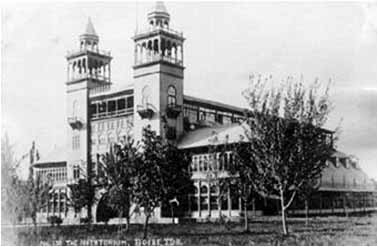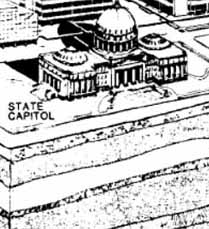
The Natatorium on Warm Springs Ave.
Source: Idaho Office of Energy Resources
Boise's Geothermal District Heating Systems (GDHS)
 |
The Natatorium on Warm Springs Ave. |
The Boise Warm Springs Water District was born out of an intense competition for a local contract to provide public water to Boise that began in 1890. In 1890 the owners of the Overland Hotel in Boise were granted permission by the city to provide a public water system by expanding the hotel’s system. They incorporated as the Boise Water Works but there was competition for the local contract from the Artesian Water and Land Improvement Company. Descriptions of the competition recall images of the Wild West, “It was reported in March 1891, in the Idaho Statesman, that ‘hatred and strife’ were rampant in Boise as a result of the battle between the two companies for customers” (Rafferty 1992, 1).
An unemployed well driller named Mr. Grumbling convinced two prominent businessman, including the director of Boise Water Works, Hosea Eastman, to drill for hot water in areas where "It did not freeze around the spot in the winter, seemed warm near the surface, and cattle had stepped in the soft earth never to appear again" (Rafferty 1992, 1). Drilling commenced in December 1890 and by March 1891 two wells had been completed with artesian flow of 550 gallons per minute at 170°F. Now able to offer hot water as well as cold, The Boise Water Works had the upper hand and soon thereafter absorbed the competition reincorporating as the Artesian Hot and Cold Water Company. The company constructed the Natatorium on Warm Springs avenue and wooden pipelines to bring the water from the new wells to the swimming complex. The complex included 50 bath and dressing rooms, a dancing and roller skating balcony, parlors, billiard rooms, card rooms, and cafe and bar (Rafferty 1992, 1). It remained in business until 1934. The pipelines were extended along Boise Warm Springs Avenue to the downtown area to serve homes and businesses and the world’s first geothermal district heating system was born.
Despite the projected savings over heating with wood and coal, customers were hard to attract as they doubted the system’s reliability. As a marketing campaign, during the coldest months, two directors of the company hosted numerous social gatherings at their homes which were connected to the heating district and an attractive low monthly rate was offered. Within a few years the distribution system included 4.5 miles of pipes serving 200 homes and 40 businesses (Rafferty 1992, 2). Throughout the coming decades the company sought to increase the flow by drilling more wells. Around 1912 two wells with electric powered pumps were installed. A variable speed pump was installed in 1927 allowing the system to be cycled on and off more efficiently. The well house was adjacent to the Idaho State Penitentiary and was staffed by prisoners 24 hours a day. Employees of the company, now known as the Boise Water Corporation, monitored the system’s pressure gauges downtown. When adjustments were needed, supervisors contacted their trustees when in the well house through the prison switchboard and advised them on how to adjust the pump speed. This management system continued until the 1970s.
The Boise Warm Springs GDHS has remained reliable throughout its history. Piping consisted of wood-stave construction until 1910 when it was replaced with steal alloy with lead and oakum connections. Cast iron was used from 1937 until 1982 when it was replaced by asbestos cement piping. Boise Warm Springs is an open system with waste water is disposed of at the end of each customer’s line, either in irrigation ditches, storm sewers, or surface drains. The system, now called The Boise Warm Springs Water District, is a subdivision of the State’s Water and Sewer department. Users are members who elect a five member board to manage the district. New customers pay all the construction costs of being connected to the district system. In 2008 there were 275 customers (Thorsteinsson 2008, 63).
Despite the success of the Warm Springs Water District, Boise did not add another geothermal district heating system until the Idaho Capital Mall system in 1982. The system heats 1.5 million square feet in nine public buildings including the state capital building. Eight of the buildings have back up boilers and the State Geothermal District Heating System created an arrangement to use the city’s system as a backup (Thorsteinsson 2008, 62).
 |
| Click here to a view diagram of the Capital Mall GDHS |
Geothermal provides about 90% of the Mall’s heat needs (Neely 1996, 1). The Boise City Geothermal District Heating system went into operation in 1983. The city consulted businesses to gauge interest before developing the system. Energy prices fell just before the system came online so many potential customers lost interest. The system started with 23 customers and had had 58 in 2008 heating a total of 3.8 million square feet (Thorsteinsson 2008, 60). This makes it the third largest system in the country in terms of space heated and the largest in Boise (Thorsteinsson 2008, 51). The rates have been fixed at 70% of the price of natural gas. High energy costs in recent years have increased interest in the system, but over the years the Boise City System has had difficulty meeting operational costs (Thorsteinsson 2008, 88).
The last system to be developed in Boise was the Fort Boise Veterans’ Hospital system which was completed in 1987. Thirty-three of the hospital complex’s forty buildings are served by the system totaling 450,000 square feet. Early this year the city received $1,400,000 from the U.S. Department of Energy (DOE) and $665,000 from the Department of Housing and Urban Development (HUD) to help connect Boise State University to the City’s district heating system. This will be done in two phases and will add five buildings and 280,000 square feet to the system (IBR Staff). All four of Boise’s DHS belong to the Boise Front Low Temperature Geothermal Resource Ground Water Management Area created in 1987 as an initial response to depletion of the aquifer and a moratorium on further development went into effect in 1988. This expansion has been made possible by the successful addition of a reinjection well to recharge the geothermal aquifer in 1998. This 3,200 foot deep well led to the City of Boise being granted a 15% increase in production in 2002 (http://www.energy.idaho.gov/renewableenergy/district_heating.shtml).